March 12, 2007
Dear Friends and Family,
It really began last October. Two
feet of snow fell before Hallowe’en. Then we got a
few inches in November followed by over five feet (66") in December.
The pattern of weekly snowfalls continued through most of January and
featured many days of high winds (i.e., +40 mph) with gusts often over
60 mph. You
may have seen Denver’s traffic snarls and eastern plains road
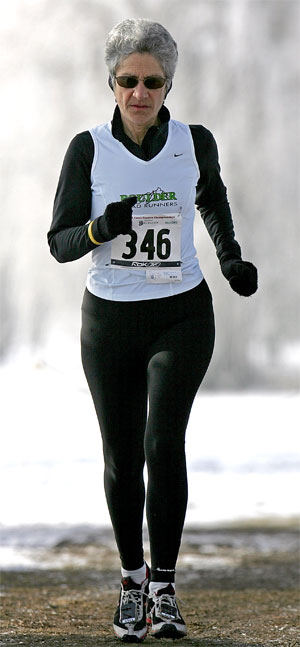 closures on your evening news. Did I say it has
been cold? Until this week, daily highs this winter have usually been below
freezing, nights in the teens and single figures. Even local old-timers have
had to reach way back in their memories to recall a longer cold snap than the
winter of 2006–7. The
St.
Patrick’s Day snowfall in 2003 brought more snow at one time, but cold,
snow, and wind all at the same time for as long a stretch as we’ve had
might cause even the sweetest among mountain folks to utter a discouraging word.
closures on your evening news. Did I say it has
been cold? Until this week, daily highs this winter have usually been below
freezing, nights in the teens and single figures. Even local old-timers have
had to reach way back in their memories to recall a longer cold snap than the
winter of 2006–7. The
St.
Patrick’s Day snowfall in 2003 brought more snow at one time, but cold,
snow, and wind all at the same time for as long a stretch as we’ve had
might cause even the sweetest among mountain folks to utter a discouraging word.
We have snow in our back meadow and in the woods around us that
probably will be here until July. We had a front end loader in twice to clear our road
of fresh and/or drifted snow so that the guy who plows with his pick’em up truck
had a place to move the snow. Our stiff upper lips, forced cheerfulness, and outward
toughness began to erode shortly after the first of the year.
I. WINTER RUNNING
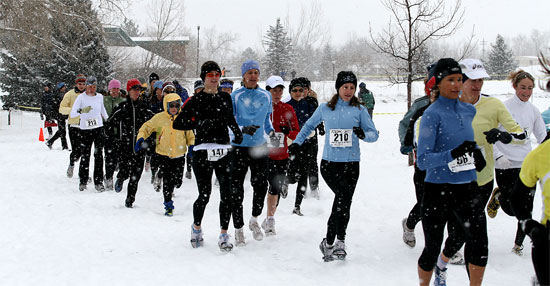
In the midst of this terrible winter weather, Judy continued to run,
both in Boulder and up here. She competed in three races, taking a team first, two individual
firsts, and an individual fourth. She won a very local and low-key prediction run in
Boulder on January 2, and was the first senior woman (60+) in the popular (and very snowy)
Best
Cross-Country Race on the Planet at the end of January (Judy’s in the center of
the photo of the group start in black cap and dark glasses).
Two weeks later, she took fourth in the
2007
USA Cross Country Championships held this year in Boulder on February 10. Her team won
their age group (60–69) for the third year in a row. Next year the nationals will be
held in San Diego, a welcome change from the snow here this year, the bitter cold in New York
City last year, and the slop and mud of Portland, Oregon the year before.
II. GETTING OUT OF TOWN
During all this we developed an intense itch to get out of
town—to go south, to visit the sandhill cranes and hummingbirds in their winter nesting
areas—anyplace where shorts and a T-shirt are the only necessary attire. For the first
time since we moved out here 15 years ago, the life of snowbirds crept into our dreams and
thoughts. Postcards from Ohio friends who spend two months in the Florida Keys only fueled
our desires. (The postcard with the split photos contrasting “You” standing
knee-deep in snow on the left with “Us” walking a sandy beach was particularly
poignant and convincing. Thank you, Jack and Anne!)
We took action. We learned what we could on-line, read lots of brochures,
and laid out $8 apiece to spend a day at the Denver RV show in January in search of a new RV.
We bargained hard for those “deepdiscounts,” “good for today only”
“show prices too good to pass up,” and in the end did something most unlikely
(for us): We bought a new 2006 Itasca Navion on eBay(!) from a dealer in Delta, Ohio. We won the bid
(we were, after all, the only bidders) and saved a bundle.
Hughes flew to Detroit where old friend, one-time Silverton cabin builder,
Shanghai rummy maven, and fisherman extraordinaire Dick Sanders picked him up and drove
him to J & G Pizza in Sylvania (Ohio) for a taste of the best gyros in the country. He stayed
the night with Dick and Trish (they played Shanghai rummy until well past midnight). In the morning
Dick drove him to Delta, 30 miles west of Toledo, to sign the papers and check out the new RV.
Hughes left Delta about noon, filled up with diesel at the nearest station, got on the Ohio Turnpike,
and headed west.
You may recall from news reports that the weekend of February 3 was incredibly
cold across the 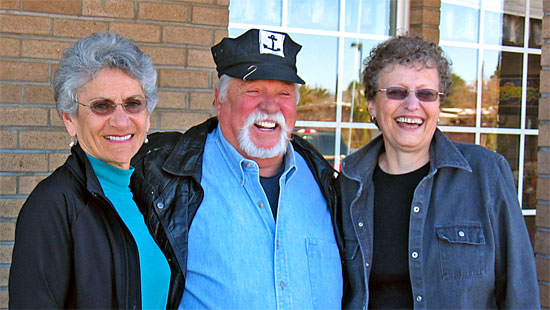 Midwest. Hughes drove to Davenport, Iowa where he spent the night, while outside the temperature
dipped to minus five and the snowless winds howled. In the morning, the engine wouldn’t start! He
turned the key and nothing happened! Not a single chug or click. He was finally towed to a trucker’s
service facility where a few dollars under the table to the service manager got him in ahead of a long
line of big rigs waiting for repairs. The mechanic heated the engine, thawed the fuel, checked the fuel
filter, sold him a bottle of diesel additive (“Put in about an inch or two with every fill-up
between here and Colorado, and if you have to stop for a quick nap, for God’s sake leave the engine
running if it’s cold.”) and sent him on his way. He left Davenport in the early afternoon and,
with time out for a quick nap—with the engine running—some coffee stops and breakfast, was
home before noon the next day, February 5.
Midwest. Hughes drove to Davenport, Iowa where he spent the night, while outside the temperature
dipped to minus five and the snowless winds howled. In the morning, the engine wouldn’t start! He
turned the key and nothing happened! Not a single chug or click. He was finally towed to a trucker’s
service facility where a few dollars under the table to the service manager got him in ahead of a long
line of big rigs waiting for repairs. The mechanic heated the engine, thawed the fuel, checked the fuel
filter, sold him a bottle of diesel additive (“Put in about an inch or two with every fill-up
between here and Colorado, and if you have to stop for a quick nap, for God’s sake leave the engine
running if it’s cold.”) and sent him on his way. He left Davenport in the early afternoon and,
with time out for a quick nap—with the engine running—some coffee stops and breakfast, was
home before noon the next day, February 5.
SNOWBIRDING IN NACO…
The following Sunday, the day after Judy’s National Cross Country race,
we packed, bundled up the dogs, and bee-lined our way south on I-25 through Denver, Pueblo, Raton Pass,
Santa Fe, Albuquerque, Socorro, Hatch
(famous for their chiles), west to Deming, Lordsburg, across the Arizona border to Bisbee and finally
to Naco, home of the Turquoise Valley Golf
and RV Park which boasts the only golf course for miles and a RV park with a hundred trailers,
fifth wheels, mini-motorhomes, and diesel pushers crammed with retired golfers from all over the USA
and western Canada.
Our intent in going there was to spend a couple of days with Judy’s cousin
and her husband, an avid golfer, and to warm up! While the low 50s wasn’t as warm as we’d
hoped, we were able to finally shed our heavy jackets and mittens. Carol and Ken seemed to welcome us
as a diversion from the world of golf for at least a few days. We had an unexpected and delightful
meeting in Sierra Vista with another of Judy’s cousins, Bob, (pictured here with Carol and Judy)
who drove down from Tucson with his wife, Ginny. We talked family (Bob remembers everyone!) and got caught
up with each other’s lives. The next day we drove east to
Agua Prieta, just across
 the Mexican
border from Douglas for a morning of playing touristas followed by a fine dinner that evening at
Santiago’s in Bisbee. In between we spent the afternoon watching the sandhill cranes at a wildlife
refuge up Whitewater Draw north of Bisbee.
the Mexican
border from Douglas for a morning of playing touristas followed by a fine dinner that evening at
Santiago’s in Bisbee. In between we spent the afternoon watching the sandhill cranes at a wildlife
refuge up Whitewater Draw north of Bisbee.
We left the following morning, meeting Ken and Carol at the entrance to
Ramsey Canyon, a prime birding
area in the Huachuca Mountains near Sierra Vista. We strolled for a mile or so up the canyon hoping to
see the abundance of bird life that we’d heard so much about, but we saw only a small flock of wild
turkeys and a couple of squirrels. It was early in the year and though we really appreciated the warmth,
apparently the hummers, mountain lions, bears, and other denizens of the canyon had sought the shelter
of their dens or, in the case of the hummingbirds, were still in the high deserts of Mexico.
AND IN TUCSON…
We left about noon for Tucson. On the way, we spent the night at
Lake Patagonia State Park about 20 miles
from Nogales. This area is developing rapidly: new and good-sized second homes are being built in the
rolling countryside that once was prime ranch land. Lake Patagonia is a pleasant fishing and water sport
recreation area that even in the middle of winter attracts campers from 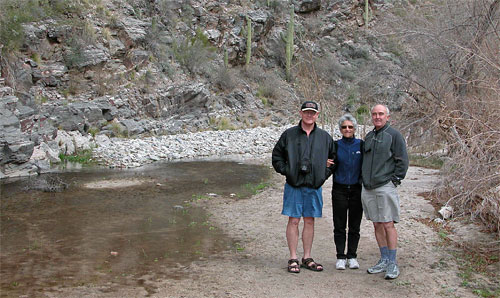 all over southern Arizona.
all over southern Arizona.
We toured the remains of a 17th century mission built by Father Kino at
Tumacacori National Historic Park and hiked along
the nearby Santa Cruz River with a ranger who spoke on the critical problems with water conservation in
the Arizona desert region.
We spent that night and the next few days with Nederland neighbors who
“winter” in Tucson. In fact, they have a condo about 20 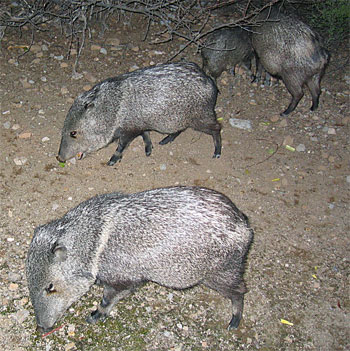 miles north in suburban
Marana, a long five iron from the site of the 2007 Accenture World Match Play Golf Tournament which
was to begin in a few days after we arrived. Heavy security and dozens of press/media trucks alerted
us that there was a “Tiger watch” in progress. We never saw Tiger, but we did see
javelinas and quail
behind their condo, lots of rabbits, and, best of all, we had several bobcat sightings when we toured
the golf course at sundown. Jim and I had a dramatic sighting of a bobcat sighting a lone rabbit on
the 11th fairway. We confess to a tinge of envy that they were spending their entire winter there
instead of toughing out winter in the Colorado mountains.
miles north in suburban
Marana, a long five iron from the site of the 2007 Accenture World Match Play Golf Tournament which
was to begin in a few days after we arrived. Heavy security and dozens of press/media trucks alerted
us that there was a “Tiger watch” in progress. We never saw Tiger, but we did see
javelinas and quail
behind their condo, lots of rabbits, and, best of all, we had several bobcat sightings when we toured
the golf course at sundown. Jim and I had a dramatic sighting of a bobcat sighting a lone rabbit on
the 11th fairway. We confess to a tinge of envy that they were spending their entire winter there
instead of toughing out winter in the Colorado mountains.
We hiked up Tucson’s scenic Sabino Canyon (on the right with neighbors Jim and Scotty) with them to see the
impact of the 10,000-year flood that struck the canyon last July; we shopped in old town Tucson near
the art museum; we stocked up on delicacies at a nearby Trader Joe’s (Don’t we wish we had
one in our area!); and spent a half day getting a few minor repairs made to the RV at La Mesa RV in
South Tucson. We left just before the official start of the golf tournament caused a near lock-down
of the neighborhood.
AT ORGAN PIPE CACTUS NATIONAL MONUMENT…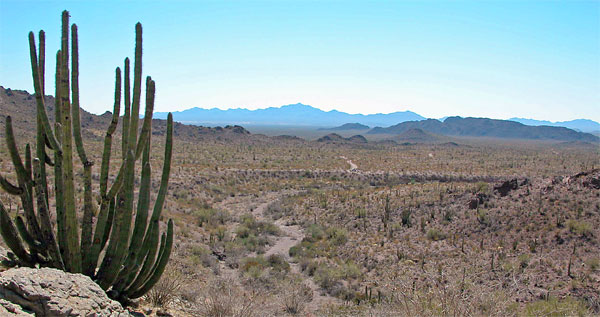
Leaving Tucson, we decided that the warmest place we might find would be south
and west of Tucson. We drove 120 miles through the Tohono O’odham nation across the waterless Sonoran desert on El Camino del
Diablo (named by the early Spaniards “The Devil’s Highway”) to the “town”
of Why (a speck on the map originally called “The Y” where you turn left to Mexico and
right to Ajo). We turned left. Another 22 miles south we pulled into the visitor’s center of
one of our most remote National Monuments:
Organ Pipe Cactus.
Along the way we passed numerous border patrol trucks and personnel.
In fact, everywhere within 50 miles of the border there are signs of active patrols in remote areas
as well as towns. Just before entering the monument, there is a check point for all vehicles going
both toward and coming from the direction of Mexico. We were stopped—briefly—only when
we drove north from the monument at the end of our stay. The patrols, plus the tall fence and security
lights that line the border as far as we could see, were constant reminders, especially at night, that
just “over there” was Mexico.
Organ Pipe Cactus is over 330,000 acres of Sonoran desert devoted to protecting
most of the few organ 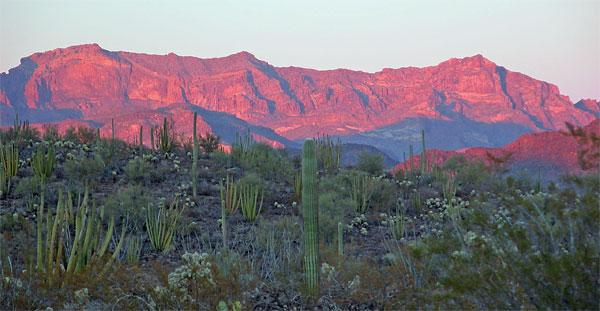 pipe cacti that exist in this country along with 25 other varieties of
cactus including lots of saguaro, several varieties of cholla, prickly pear, and senita. Even novice
birders who look hard will see lots of cactus wrens (the state bird), Gambel’s quail, and roadrunners. Gila monsters,
scorpions, and rattlesnakes can also be found when least expected. The monument is also a haven for
northerners who crave warmth, a place to hike in shorts and a T-shirt, and run or ride their bikes
on relatively flat areas free of traffic. For a mere $6 a night, we had a quiet campground with sweet
water, flush toilets, privacy, great views, nightly campfire programs, and free guided driving tours
of the back country. Some of the hiking trails were closed because of border security issues (never
really detailed, but monument officials alluded to illegal drug smuggling), but other areas offered
excellent day hikes in the Ajo Mountains.
pipe cacti that exist in this country along with 25 other varieties of
cactus including lots of saguaro, several varieties of cholla, prickly pear, and senita. Even novice
birders who look hard will see lots of cactus wrens (the state bird), Gambel’s quail, and roadrunners. Gila monsters,
scorpions, and rattlesnakes can also be found when least expected. The monument is also a haven for
northerners who crave warmth, a place to hike in shorts and a T-shirt, and run or ride their bikes
on relatively flat areas free of traffic. For a mere $6 a night, we had a quiet campground with sweet
water, flush toilets, privacy, great views, nightly campfire programs, and free guided driving tours
of the back country. Some of the hiking trails were closed because of border security issues (never
really detailed, but monument officials alluded to illegal drug smuggling), but other areas offered
excellent day hikes in the Ajo Mountains.
AND IN ALBUQUERQUE…
On our return home we drove through sprawling Phoenix; we passed the copper
mining areas around Miami and Globe that are trying to make a comeback without dependence on copper;
through the scenic Salt River Canyon on the Fort Apache Reservation; past Show Low and
Springerville (which has a terrific
visitors center), across the snowy high desert of western New Mexico; past
Pie Town (we really should have stopped at the
cafe in this tiny dot on the map that makes their own pies to see if they live up to the town’s
name); past the V(ery) L(arge) A(rray) of radio
telescopes that sit on the south side of US 60 in the middle of nowhere monitoring the universe); a
quick stop at Evetts’ Cafe
in Magdalena for a homemade milk shake; through Socorro and north on I-25 to Albuquerque—just
making a fuel stop before we ran out of fumes. Judy was driving when the “out of fuel”
light came on; you can imagine her reaction.

Ken and Anna Marie lived across the street from us in Ohio 37 years ago where
we played a lot of bridge and drank a few beers together. They moved to Houston in the mid-70s and
then to Albuquerque where they have lived for about 25 years (has it really been that long?) We kept
in touch all these years, and when Ken died suddenly a year and a half ago, we’ve especially
tried to make Albuquerque a travel stop whenever possible (if Anna Marie is home; she travels a great
deal so we’re never sure). We talked a lot, catching up on family news and travels. We did some
shopping (both she and Judy do that quite well), visited with her son and his wife who also live in
Albuquerque, enjoyed some of Anna Marie’s fine homemade enchiladas, had an expensive afternoon
drink at a fancy resort north of town (choked on the bill), and visited
Coronado State Park in Bernalillo where ranger Elmer Leon taught us about the
kivas and other ruins of the Kuaua pueblo people. Mr. Leon has a wealth of knowledge, a good sense
of humor, and a real passion for the history of this area. The tour (just the four of us) reminded
us that guided tours can teach us much more than if we just wandered through an area on our own or
even with a self-guided map.
Our winter get-away was just the cure for the winter blahs. We returned the
day before another winter storm hit Colorado. While we had some pretty strong cross winds coming
through southern Colorado on the way home, we made it safely down our drive and parked the RV in
our turn-around area before the storm broke. We woke the next morning to a half foot of snow and
watched the news broadcast of traffic pile-ups on the stretch of I-25 we’d come through the
day before. We were lucky (and we listened to the weather news, of course). We had time to unload
the RV, warm the house with a fire in the wood stove, and be grateful for the good weather we had
for the past two and a half weeks.
III. OTHER NEWS
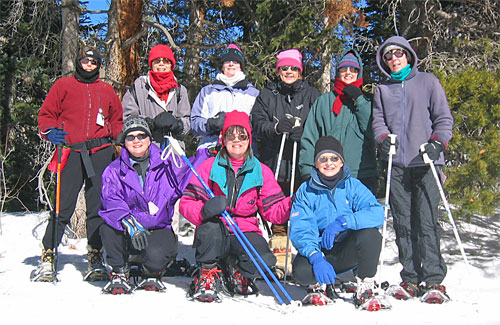 • RMTS Snowshoeing.
For the past six months, Judy has been part of a couple of different cancer survivor support
groups. One provides weekly guided talk therapy and one is a group of active women who walk
together weekly in Boulder and work out Thursday nights at a local fitness center, though Judy
hasn’t participated in this. However, with the really good snow at our local ski area,
Eldora Mountain Resort, Judy organized
the walking group, plus any other members of the RMTS (Rocky Mountain Team Survivors) who
choose to join in, to go snowshoeing twice this winter. A couple of hours on the trails have
been followed by a potluck lunch at our place. Attendance has been enthusiastic, the food
terrific, and the snow as good as it ever has been. There are so many ways in which cancer
survivors can help each other, and being active together is a very positive and beneficial
approach.
• RMTS Snowshoeing.
For the past six months, Judy has been part of a couple of different cancer survivor support
groups. One provides weekly guided talk therapy and one is a group of active women who walk
together weekly in Boulder and work out Thursday nights at a local fitness center, though Judy
hasn’t participated in this. However, with the really good snow at our local ski area,
Eldora Mountain Resort, Judy organized
the walking group, plus any other members of the RMTS (Rocky Mountain Team Survivors) who
choose to join in, to go snowshoeing twice this winter. A couple of hours on the trails have
been followed by a potluck lunch at our place. Attendance has been enthusiastic, the food
terrific, and the snow as good as it ever has been. There are so many ways in which cancer
survivors can help each other, and being active together is a very positive and beneficial
approach.
• A Big Birthday
March is birthday month around here: Hughes turned 67 on the 3rd and Judy hit 65 on the
4th. We seldom mention birthdays except in the case of significant birthdays—e.g.,
those that end in “0” or our 62nd birthdays when we drove to Rocky Mountain
National Park for our Golden Age Passes. ($10 buys you, and everyone in your car, a
lifetime of free admission to all national parks, monuments, historical sights, etc.
If you’re 62 or older and don’t have one of these, you’re missing out
on the best deal this side of MacDonald’s senior coffee.). This year, Judy joined
the ranks of medicare recipients thereby easing our budget for staying healthy. Hughes
is just another year older.
• Spinning for Hope.
A few days before Judy’s birthday we got an email from Debra saying she was going
to join some other local women in her town, as well as women all over Massachusetts, in
raising money for cancer research and assistance to cancer victims through the American
Cancer Society by participating in a morning of spinning at her fitness center. She
committed to an hour, but wound up doing all three hours (about 50-60 miles she thought).
It was an especially poignant announcement (and appeal for financial support) because she
said that she was doing this for Judy who has been a cancer survivor and that the event
was taking place on March 4, Judy’s birthday. Debra alone raised over $1,000 as well
as paid tribute to Judy, who was understandably touched and teary.
• Best News Saved for Last.
We learned this morning that the results of Judy’s quarterly CAT scan came back
negative (no signs of cancer). She’ll go back in early June for another scan, but
for now she’s good to tour Italy (Milan, Vernazza, Florence, and Venice in April)
and she’ll continue training with the Boulder Striders to defend her unbeaten streak in the Bolder-Boulder
10K on Memorial Day. It’s all good very, very good news and makes our past winter
woes seem so unimportant.

 closures on your evening news. Did I say it has
been cold? Until this week, daily highs this winter have usually been below
freezing, nights in the teens and single figures. Even local old-timers have
had to reach way back in their memories to recall a longer cold snap than the
winter of 2006–7. The
St.
Patrick’s Day snowfall in 2003 brought more snow at one time, but cold,
snow, and wind all at the same time for as long a stretch as we’ve had
might cause even the sweetest among mountain folks to utter a discouraging word.
closures on your evening news. Did I say it has
been cold? Until this week, daily highs this winter have usually been below
freezing, nights in the teens and single figures. Even local old-timers have
had to reach way back in their memories to recall a longer cold snap than the
winter of 2006–7. The
St.
Patrick’s Day snowfall in 2003 brought more snow at one time, but cold,
snow, and wind all at the same time for as long a stretch as we’ve had
might cause even the sweetest among mountain folks to utter a discouraging word.
 Midwest. Hughes drove to Davenport, Iowa where he spent the night, while outside the temperature
dipped to minus five and the snowless winds howled. In the morning, the engine wouldn’t start! He
turned the key and nothing happened! Not a single chug or click. He was finally towed to a trucker’s
service facility where a few dollars under the table to the service manager got him in ahead of a long
line of big rigs waiting for repairs. The mechanic heated the engine, thawed the fuel, checked the fuel
filter, sold him a bottle of diesel additive (“Put in about an inch or two with every fill-up
between here and Colorado, and if you have to stop for a quick nap, for God’s sake leave the engine
running if it’s cold.”) and sent him on his way. He left Davenport in the early afternoon and,
with time out for a quick nap—with the engine running—some coffee stops and breakfast, was
home before noon the next day, February 5.
Midwest. Hughes drove to Davenport, Iowa where he spent the night, while outside the temperature
dipped to minus five and the snowless winds howled. In the morning, the engine wouldn’t start! He
turned the key and nothing happened! Not a single chug or click. He was finally towed to a trucker’s
service facility where a few dollars under the table to the service manager got him in ahead of a long
line of big rigs waiting for repairs. The mechanic heated the engine, thawed the fuel, checked the fuel
filter, sold him a bottle of diesel additive (“Put in about an inch or two with every fill-up
between here and Colorado, and if you have to stop for a quick nap, for God’s sake leave the engine
running if it’s cold.”) and sent him on his way. He left Davenport in the early afternoon and,
with time out for a quick nap—with the engine running—some coffee stops and breakfast, was
home before noon the next day, February 5. the Mexican
border from Douglas for a morning of playing touristas followed by a fine dinner that evening at
Santiago’s in Bisbee. In between we spent the afternoon watching the sandhill cranes at a wildlife
refuge up Whitewater Draw north of Bisbee.
the Mexican
border from Douglas for a morning of playing touristas followed by a fine dinner that evening at
Santiago’s in Bisbee. In between we spent the afternoon watching the sandhill cranes at a wildlife
refuge up Whitewater Draw north of Bisbee. all over southern Arizona.
all over southern Arizona. miles north in suburban
Marana, a long five iron from the site of the 2007 Accenture World Match Play Golf Tournament which
was to begin in a few days after we arrived. Heavy security and dozens of press/media trucks alerted
us that there was a “Tiger watch” in progress. We never saw Tiger, but we did see
javelinas and quail
behind their condo, lots of rabbits, and, best of all, we had several bobcat sightings when we toured
the golf course at sundown. Jim and I had a dramatic sighting of a bobcat sighting a lone rabbit on
the 11th fairway. We confess to a tinge of envy that they were spending their entire winter there
instead of toughing out winter in the Colorado mountains.
miles north in suburban
Marana, a long five iron from the site of the 2007 Accenture World Match Play Golf Tournament which
was to begin in a few days after we arrived. Heavy security and dozens of press/media trucks alerted
us that there was a “Tiger watch” in progress. We never saw Tiger, but we did see
javelinas and quail
behind their condo, lots of rabbits, and, best of all, we had several bobcat sightings when we toured
the golf course at sundown. Jim and I had a dramatic sighting of a bobcat sighting a lone rabbit on
the 11th fairway. We confess to a tinge of envy that they were spending their entire winter there
instead of toughing out winter in the Colorado mountains.
 pipe cacti that exist in this country along with 25 other varieties of
cactus including lots of saguaro, several varieties of cholla, prickly pear, and senita. Even novice
birders who look hard will see lots of cactus wrens (the state bird), Gambel’s quail, and roadrunners. Gila monsters,
scorpions, and rattlesnakes can also be found when least expected. The monument is also a haven for
northerners who crave warmth, a place to hike in shorts and a T-shirt, and run or ride their bikes
on relatively flat areas free of traffic. For a mere $6 a night, we had a quiet campground with sweet
water, flush toilets, privacy, great views, nightly campfire programs, and free guided driving tours
of the back country. Some of the hiking trails were closed because of border security issues (never
really detailed, but monument officials alluded to illegal drug smuggling), but other areas offered
excellent day hikes in the Ajo Mountains.
pipe cacti that exist in this country along with 25 other varieties of
cactus including lots of saguaro, several varieties of cholla, prickly pear, and senita. Even novice
birders who look hard will see lots of cactus wrens (the state bird), Gambel’s quail, and roadrunners. Gila monsters,
scorpions, and rattlesnakes can also be found when least expected. The monument is also a haven for
northerners who crave warmth, a place to hike in shorts and a T-shirt, and run or ride their bikes
on relatively flat areas free of traffic. For a mere $6 a night, we had a quiet campground with sweet
water, flush toilets, privacy, great views, nightly campfire programs, and free guided driving tours
of the back country. Some of the hiking trails were closed because of border security issues (never
really detailed, but monument officials alluded to illegal drug smuggling), but other areas offered
excellent day hikes in the Ajo Mountains.
 • RMTS Snowshoeing.
For the past six months, Judy has been part of a couple of different cancer survivor support
groups. One provides weekly guided talk therapy and one is a group of active women who walk
together weekly in Boulder and work out Thursday nights at a local fitness center, though Judy
hasn’t participated in this. However, with the really good snow at our local ski area,
Eldora Mountain Resort, Judy organized
the walking group, plus any other members of the RMTS (Rocky Mountain Team Survivors) who
choose to join in, to go snowshoeing twice this winter. A couple of hours on the trails have
been followed by a potluck lunch at our place. Attendance has been enthusiastic, the food
terrific, and the snow as good as it ever has been. There are so many ways in which cancer
survivors can help each other, and being active together is a very positive and beneficial
approach.
• RMTS Snowshoeing.
For the past six months, Judy has been part of a couple of different cancer survivor support
groups. One provides weekly guided talk therapy and one is a group of active women who walk
together weekly in Boulder and work out Thursday nights at a local fitness center, though Judy
hasn’t participated in this. However, with the really good snow at our local ski area,
Eldora Mountain Resort, Judy organized
the walking group, plus any other members of the RMTS (Rocky Mountain Team Survivors) who
choose to join in, to go snowshoeing twice this winter. A couple of hours on the trails have
been followed by a potluck lunch at our place. Attendance has been enthusiastic, the food
terrific, and the snow as good as it ever has been. There are so many ways in which cancer
survivors can help each other, and being active together is a very positive and beneficial
approach.